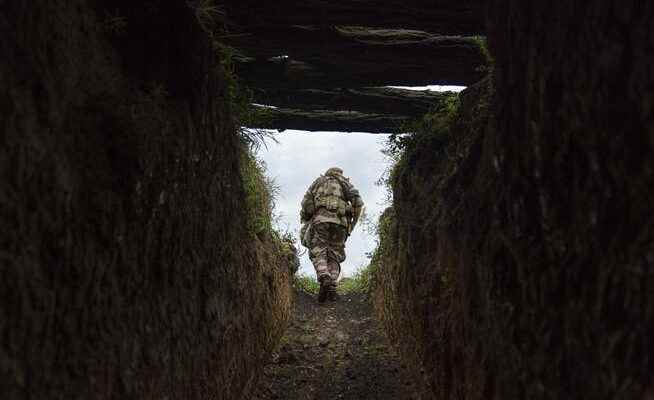The Russian army has made a breakthrough on a section of the Donbass front that has been contested for months. The success, which came as a surprise to many observers, highlights the insufficient equipment of the Ukrainians, but also errors in their military leadership.
In a defensive fight against Russia, the Ukrainians have dug kilometers of trenches in the Donbass. They were driven out of their positions near Donetsk this week.
The Ukrainian armed forces had only just felt on the upswing: after the devastating battles in June in the east of the country, the daily death toll had fallen sharply, the Russian offensive seemed to have run out of steam, and thanks to the high-precision American Himars rocket launchers, the Ukrainians were able to the southern province of Cherson interrupting the enemy’s supply routes. But the bad news has caught up with the defenders again.
In one of his evening video addresses this week, President Volodymyr Zelensky described what is currently happening on some front sections in the Donbass as “simply hell”. Zelenskiy was referring to the enemy’s hail of shells falling on the cities of Avdiivka and Pisky. The two places are close to the metropolis of Donetsk, which serves as the capital for the Moscow-based separatists of the “Donetsk People’s Republic”.
The Russians made a potentially momentous breakthrough on this front this week. The Ukrainians had to retreat over a distance of around 20 kilometers. Apparently, Piski has mostly fallen, and the situation is becoming precarious for the defenders of Avdiivkaz. On the map, Russia’s territorial gains don’t look spectacular; it’s about a few tens of square kilometers. That is why the military leadership in Kyiv and some Western experts are downplaying the setback.
Positions built up over the years
But the Russian advance, which came as a surprise to many observers, is significant because it was one of the most heavily fortified front sections in the country. Since the ceasefire of 2015, the so-called Minsk Agreement, the Ukrainians had dug a system of trenches here to be armed against the separatists of the Donetsk «People’s Republic». While the Russians were able to break through the old armistice line in many places after the February 24 invasion, the positions at Piski held for more than five months.
But now the Ukrainians have had to give up, among other things, a coal mine used for defense and the parts of Donetsk International Airport that they control. The following video illustrates how parts of Piski are under fire.
Пески под обстрелом z-army сейчас. ВСУ продолжают контролировать часть поселка pic.twitter.com/sqIxc215Og
— IgorGirkin (@GirkinGirkin) August 6, 2022
The Russian advance does not represent an actual breach of the dam. This is due to the fact that the attackers lack the necessary forces to quickly make up further ground. However, corresponding reinforcements must be expected. Russia has an interest in further pushing back the Ukrainians in order to improve Donetsk’s strategic position. The outskirts of the big city have so far been almost directly at the front.
The challenge for the Ukrainians is to set up a new defense in the shortest possible time. Otherwise there is a risk of encirclement of Avdiivka, an industrial city that once had 30,000 inhabitants and is best known for the largest coke factory in the country. According to its mayor, Vitaly Barabash, around 2,500 civilians are still holding out in Avdiivka. They are living in appalling, inhumane conditions, he told on Wednesday Radio Liberty. There is neither gas nor water. When shelling the city, Russia used heavy flamethrower systems, one of the most feared weapons in the Russian arsenal because its rockets generate enormous heat and can burn large areas.
Call for help from the front
The Ukrainian generals were obviously taken by surprise by the Russian offensive. Although reinforcements are said to have arrived in the meantime, the defenders were fatally undermanned beforehand. The testimony of a young non-commissioned officer, who on Tuesday on Facebook made the following call for help: “What else can be taken from me on the sixth day of my personal hell in Piski? The corpses of those dearer to me than family lie in the devastated trenches in the heat.”
6,500 shells fell on this town every day, wrote the squad leader of a volunteer unit. His poorly armed infantry battalion was barely able to respond. Counter-attacks with artillery, so-called counter-battery fire, were completely absent. As a result, the opponent systematically eats through the strongest defensive positions. He feels like cannon fodder; his soldiers could face the attacks “only with their bare bodies”.
The report suggests that the Ukrainians still haven’t found a recipe for stopping Russian artillery – a veritable machine of destruction. The destruction of dozens of Russian ammunition depots by American Himars missiles has attracted attention, but it has by no means exhausted Russia’s stockpiles of shells. At Piski, the Ukrainians also lacked any artillery, let alone western precision guns.
Heavy fighting also around the town of Bakhmut
(dpa) According to information from Kyiv, Russian troops are attacking the city of Bakhmut, a cornerstone of the Ukrainian defense system in the Donbass, with all their might. “The fighting continues,” said the Ukrainian General Staff in its situation report on Saturday. The day before, the pro-Russian units had reported that fighting was already taking place within the city area. This information could not be verified. Since the capture of the Luhansk Oblast, Russian offensive efforts in eastern Ukraine have focused on the neighboring Donetsk Oblast. They now control about 60 percent of it. The headquarters of the Ukrainian troops in the Donbass is located in the Sloviansk-Kramatorsk conurbation, where a good half a million people lived before the war. This area is secured from the east by the Siwersk – Soledar – Bakhmut fortress line, which is now beginning to falter in several places.
